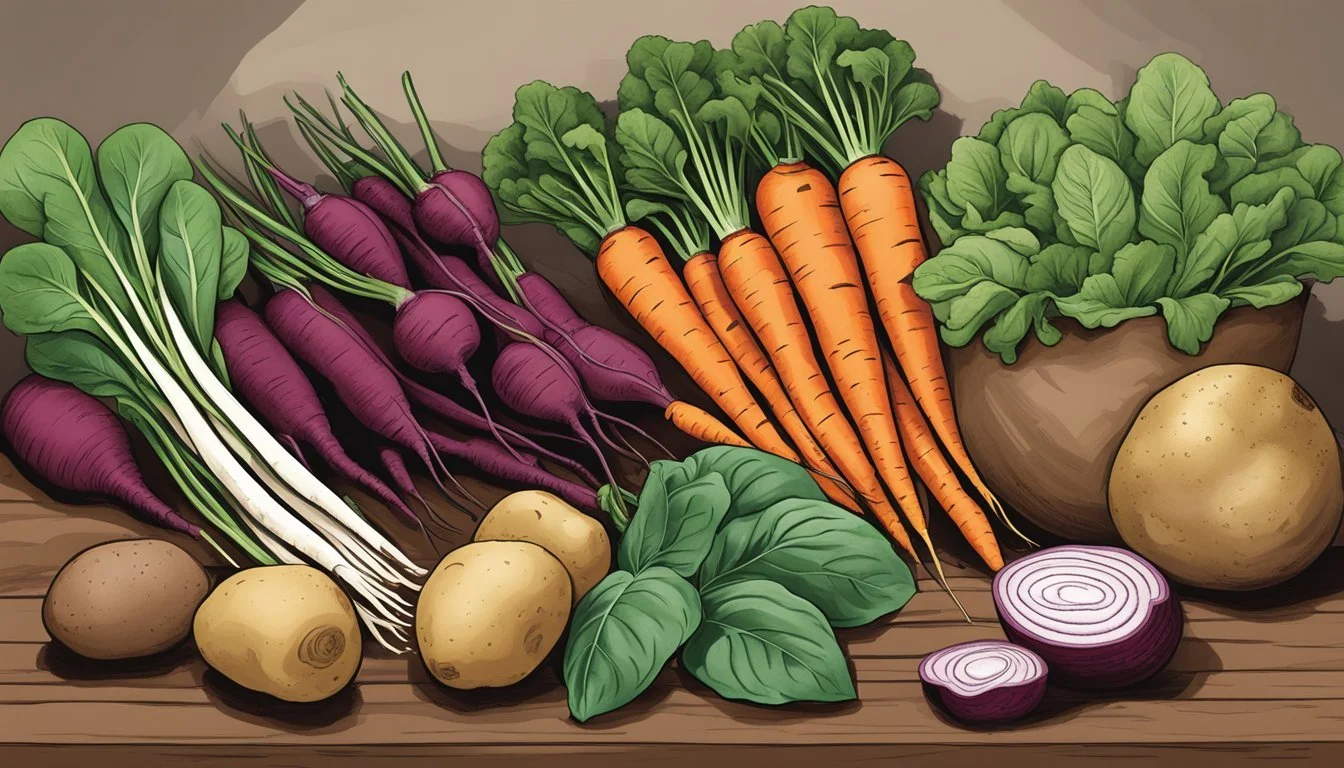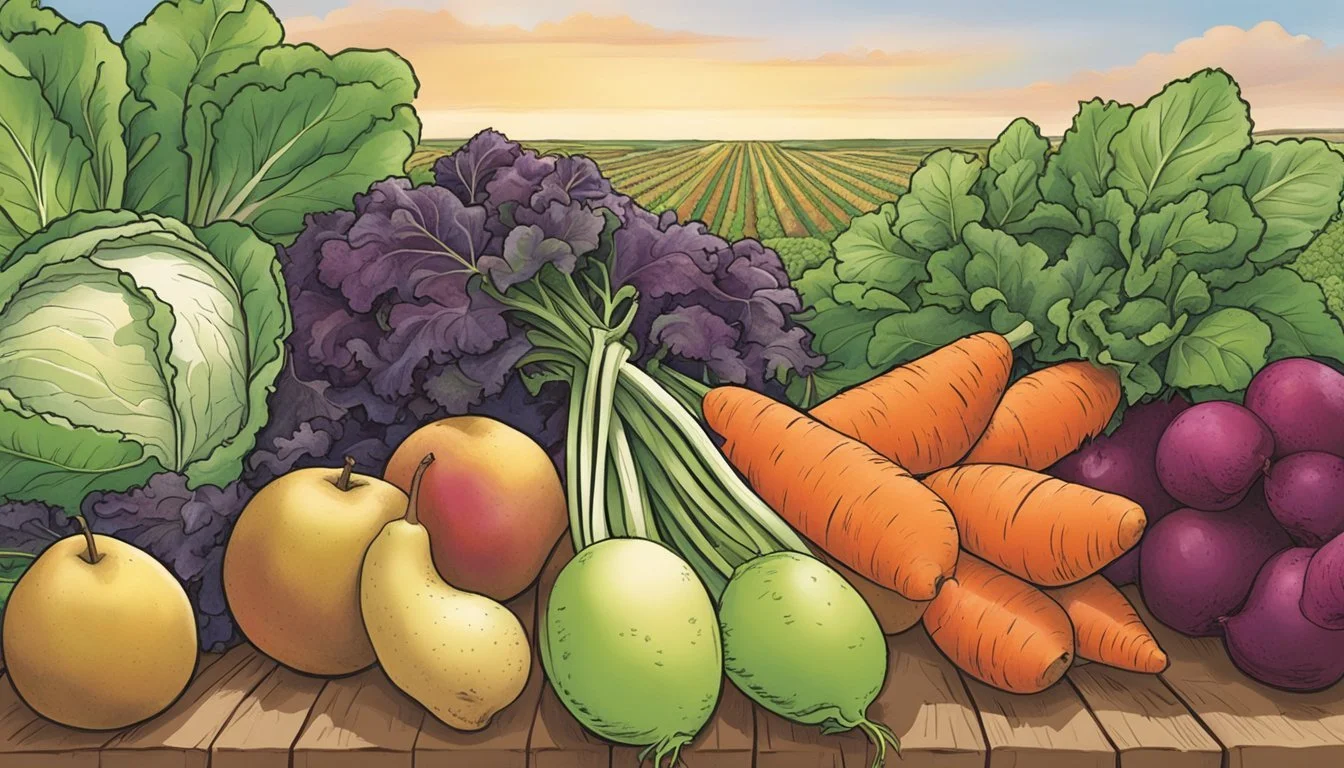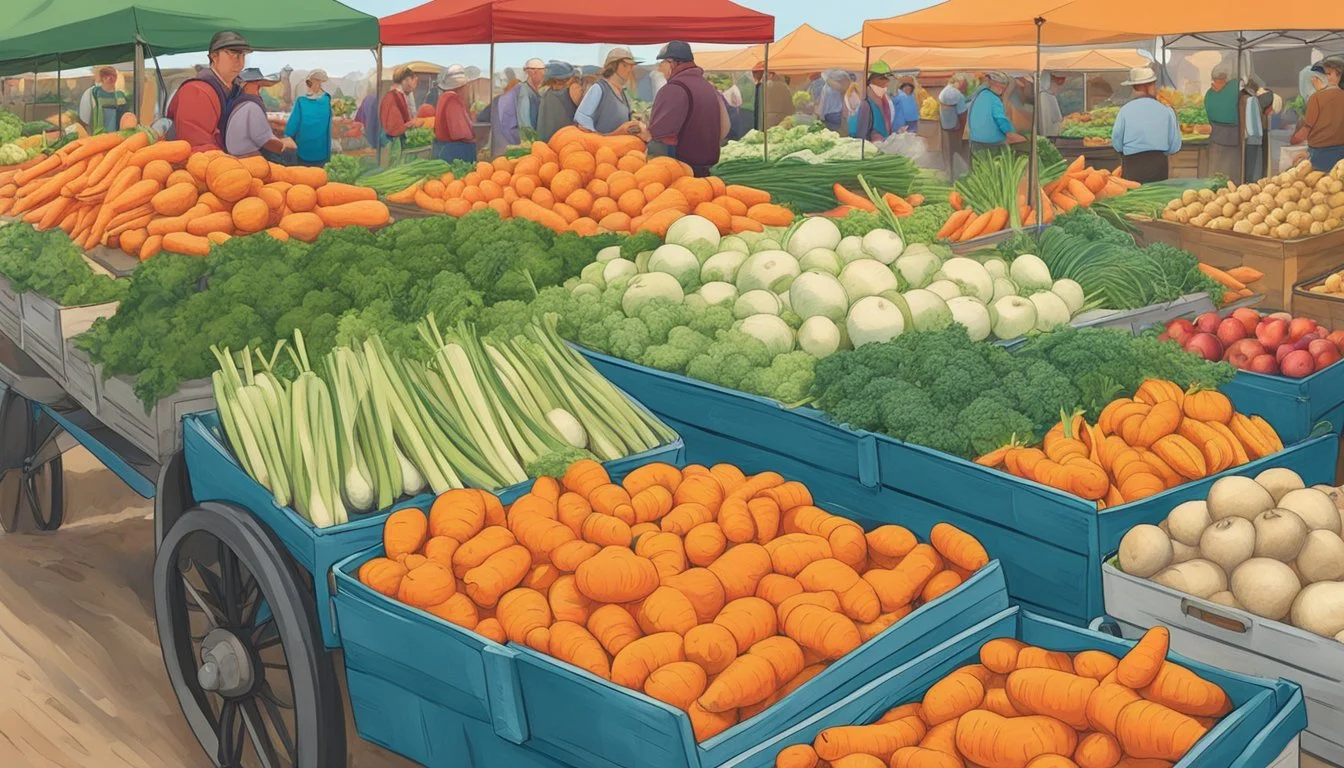North Dakota Seasonal Fruit & Vegetables in March
A Monthly Guide
This Article is Part of our North Dakota Seasonal Fruit & Veg Calendar
In North Dakota, the progression of the seasons critically influences the availability of fresh produce, and as March heralds the end of winter, the selection of fruits and vegetables begins to shift. While March does not offer the same abundance as the warmer months, there are still several seasonal items that thrive in the cool transition period. Root vegetables and various storage crops from the previous harvest remain staples, providing a reliable source of nutrition and flavor.
The state's growers, experienced in working with the harsh climate, have managed to extend the season of some produce, ensuring a wider variety. Even as the snow continues to thaw, consumers can expect to find local products such as hearty greens, which can be grown in cold frames or tunnels, and stored goods like winter squash, onions, and potatoes that maintain their quality well into early spring. These items reflect the resilience of the regional agriculture and the commitment of North Dakota farmers to provide fresh options throughout the year.
Overview of North Dakota's Seasonal Produce
As North Dakota transitions from winter to spring, the variety of seasonal produce begins to shift. March brings unique climatic conditions that affect the availability and quality of fruits and vegetables in the region.
Transition from Winter to Spring Produce
In March, consumers may find the tail end of winter produce still available, while the earliest spring vegetables start to emerge. Cold storage crops like potatoes and apples are typically still in supply from the previous fall's harvest. They may also find that some greenhouse-grown products, such as certain types of lettuce, herbs, and perhaps some hearty greens, are available due to controlled environment agriculture.
March's Unique Climatic Impact on Produce
The climate in North Dakota during March can be quite variable, often impacting what farmers can provide. Despite the cold, some hardy early spring crops begin to become available. These may include:
Root vegetables: such as parsnips and carrots.
Leafy greens: like spinach and kale, which can withstand cooler temperatures.
As the soil begins to warm, these early starters signal the coming abundance of fresh produce that will flourish in the ensuing months. However, the selection remains limited as the colder weather persists, delaying the planting and growth of a wider variety of fruits and vegetables.
Seasonal Vegetables in March
In March, North Dakota's markets begin to showcase an array of fresh vegetables, each packed with unique nutritional benefits. The chill of winter starts to wane, allowing for the introduction of robust greens and a variety of hearty vegetables to the local produce selection.
Health Benefits and Nutritional Value
Greens such as arugula, spinach, and kale emerge in March, offering high levels of vitamins A, C, and K, along with minerals like iron and calcium. These leafy vegetables are not only rich in fiber but also possess antioxidants, which contribute to overall health and disease prevention.
Peas are another spring vegetable that begin to appear. They are abundant in vitamins B1, B6, C, and K, and impart a good amount of dietary fiber.
Cabbage, with its impressive vitamin C content, acts as a nutrient powerhouse that supports the immune system.
Broccoli and cauliflower come into season, both cruciferous vegetables known for their cancer-fighting properties, high in vitamin C and folate.
Bold flavors and nutritious profiles make these vegetables substantial assets to any meal during the early spring in North Dakota.
Preparing and Cooking Seasonal Vegetables
When it comes to preparation and cooking, each vegetable offers versatility:
Cabbage can be shredded for fresh salads or sautéed as a warm side.
Arugula adds a peppery taste to salads, while spinach can be enjoyed both raw or cooked – wilting down significantly when heated, which is perfect for adding to dishes where space is limited.
Kale has a sturdier texture, suitable for baking into chips or stewing in soups.
Artichokes (how long do artichokes last?) present a more unique option in March and can be boiled or steamed to reveal their tender hearts, a delicacy that pairs well with a variety of dips and sauces. Radishes provide a crunchy, spicy element to dishes and are often used in salads or as garnishes.
Leeks, with their mild onion flavor, are excellent in soups and pies or can serve as a substitute for onions in many recipes.
Cauliflower and broccoli are highly adaptable, able to be roasted, steamed, or mashed as a healthier alternative to potatoes.
It's recommended to consume celery in its raw form to retain the crisp texture and its nutrient-dense profile.
For all these vegetables, simplicity can be key; a light steaming or a quick sauté with a splash of olive oil and a sprinkle of salt often yields the best results, highlighting their natural flavors and preserving their nutritional integrity.
Seasonal Fruits in March
March in North Dakota welcomes the crisp and refreshing flavors of stored apples and pears, alongside the zesty tang of various citrus fruits. These fruits offer a myriad of health benefits and culinary uses.
Including Local Fruits in Your Diet
Integrating local fruits into one’s diet supports the regional economy and ensures the consumption of produce at its peak flavor and nutritional value. Apples, preserved from fall harvest, maintain a balance between sweetness and acidity, making them perfect for both fresh consumption and cooked dishes. Pears, another fall-harvested fruit, complement both sweet and savory profiles with their soft, buttery texture. Citrus fruits, primarily imported due to the northern climate, arrive in supermarkets with a burst of flavor and vitamin C, excellent for boosting immunity during the tail end of winter.
Fruit Preservation and Storage Techniques
Proper preservation and storage techniques are crucial for extending the life and quality of fruits. Apples should be kept in cool, ventilated spaces away from strong-smelling foods to prevent flavor absorption. They remain firm and can be stored for months under the right conditions. Pears benefit from cold storage as well, which slows ripening. Once ripe, they should be eaten within a few days to enjoy their optimal flavor. Citrus fruits require a cool, dry environment, away from direct sunlight. Refrigeration can extend their freshness, allowing them to retain their vibrant taste and nutritional benefits over time.
Recipes and Usage Ideas
In North Dakota, March heralds the transition from winter to spring, offering a mix of hearty vegetables and the beginning of fresher flavors. This section provides a selection of recipes and usage ideas tailored to the season, highlighting ways to incorporate local produce into everyday meals.
Vegetable-Centric Dishes
Incorporating seasonal vegetables into main courses can be both nutritious and flavorful. Salads made with arugula, spinach, and radishes provide a crisp and refreshing side or starter. For example, a robust Roasted Beet and Carrot Salad combines the earthy tones of root vegetables with a tangy vinaigrette.
For heartier options, Soups are ideal for the last of the chilly days. A Slow Cooker Vegetable Beef Soup utilizes root vegetables like parsnips, onions, and carrots, making it a satisfying option that can cook throughout the day.
Pasta (how long does pasta last?) dishes can be a canvas for seasonal vegetables as well. One could prepare a Pasta with Roasted Brussels Sprouts and Balsamic Reduction, where the caramelization of the sprouts offers a dance of sweet and bitter, perfect when tossed with al dente pasta.
Fruit-Infused Flavors
While March might be slim on local fruits in North Dakota, one can still enjoy infusions of zest from available citrus to brighten dishes. Side dishes like Grilled Asparagus (how long does asparagus last?) with Lemon Zest (how long does lemon zest last?) highlight the transition into spring with their simple yet bold flavors. The asparagus can be lightly grilled to maintain its snap and complemented with a spritz of lemon to bring a burst of freshness.
Though fresh fruits are scarce, incorporating preserved or stored fruits into recipes can offer a welcome hint of sweetness. Apple Chutney, made from the previous season's harvest, can be a wonderful accompaniment to a roasted pork dish, providing a sweet and tangy flavor contrast.
For a subtle use of fruit flavors, consider preparing a Spinach Salad with Citrus Vinaigrette, where the tanginess of the dressing pairs wonderfully with the subtle bitterness of fresh spinach leaves.
Seasonal Harvest and Availability
March in North Dakota marks a period where the availability of fresh produce begins to transition. Despite the chilly climate, local markets and farms offer a selection of cold-tolerant vegetables and stored harvest from the previous growing season.
Local Markets and Farms
Local markets and farms in North Dakota during March may not have the abundance seen in peak summer months, but one can still find a variety of produce. Products typically available are those that store well over winter or are harvested early in the year. Storage vegetables like potatoes, onions, and carrots are commonly found, as well as some greenhouse-grown items such as lettuce and herbs. The produce one finds is often organic, adhering to sustainable farming practices that support the local ecosystem.
Available Produce Category Storage or Greenhouse Potatoes Vegetable Storage Onions Vegetable Storage Carrots Vegetable Storage Lettuce Vegetable Greenhouse Herbs Seasonings Greenhouse
Importance of Seasonal Eating
Eating seasonally in North Dakota is significant for numerous reasons. Seasonal fruits and vegetables harvested at the peak of their freshness offer enhanced flavor and nutritional content. Supporting local agriculture by purchasing seasonal items also boosts the local economy and reduces environmental impacts associated with long-distance food transportation. Seasonal eating encourages a diverse diet that changes throughout the year, aligning with the natural cycle of the region.
Agricultural Practices in North Dakota
In North Dakota, agricultural practices are a blend of organic and conventional methods that support the state’s economy and play a significant role in the environmental stewardship of the region. These practices vary widely, yet they are united by the state's commitment to sustainable farming.
Organic and Conventional Farming
North Dakota's farmers are diversified in their approach to agriculture, with organic farming coexisting alongside conventional farming techniques. Organic farms avoid synthetic fertilizers and pesticides, adhering to standards that emphasize the use of renewable resources and the conservation of soil and water. In contrast, conventional farming often utilizes a range of modern agricultural technologies, including chemical fertilizers and genetically modified organisms, to maximize productivity.
Organic Practices:
Use of natural fertilizers such as manure or compost
Crop rotation and cover cropping for soil health
Integrated pest management using beneficial insects
Conventional Practices:
Application of synthetic fertilizers for nutrient management
Use of chemical pesticides and herbicides for crop protection
Adoption of genetically modified crops to increase yield and resistance to pests
Impact on Local Economy and Environment
The agricultural sector is a cornerstone of North Dakota's economy, contributing significantly to local communities and the United States at large. Data from the North Dakota Department of Agriculture highlights the importance of the industry, which exports commodities such as grain products and vegetable oils.
The environmental impact of farming practices in the state is carefully considered. Sustainable farming initiatives aim to reduce the ecological footprint and preserve the land for future generations.
Economic Contributions:
Export of agricultural commodities bolsters the state’s international trade.
Creation of jobs and support of ancillary industries related to agribusiness.
Environmental Stewardship:
Promotion of conservation efforts to maintain wildlife habitats and biodiversity.
Implementation of practices to mitigate soil erosion and water contamination.







